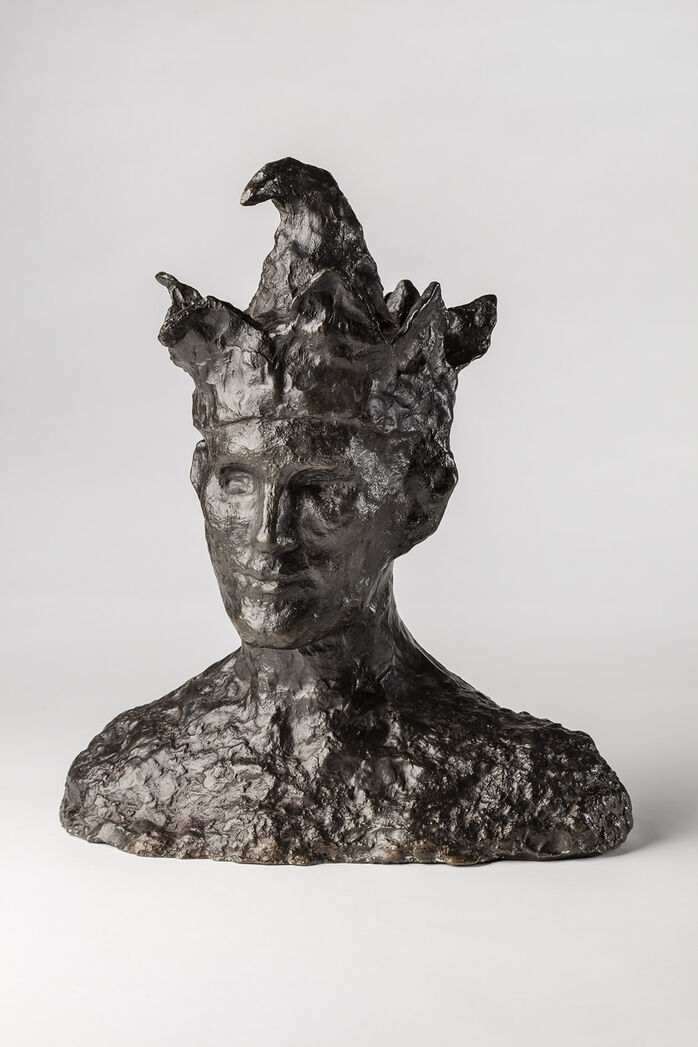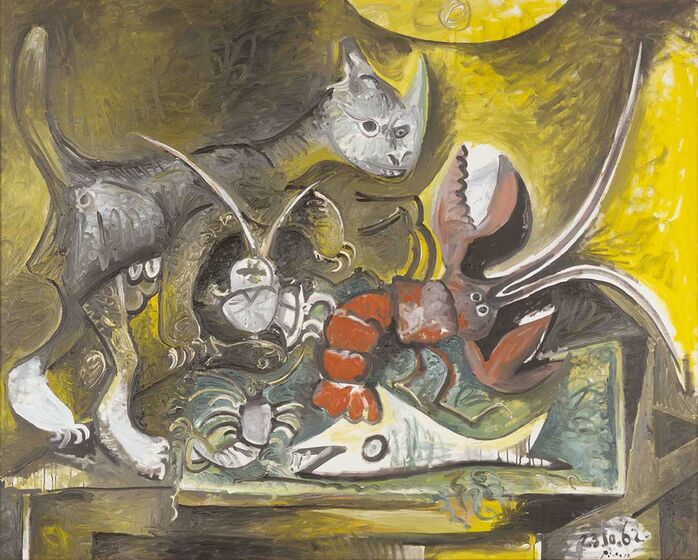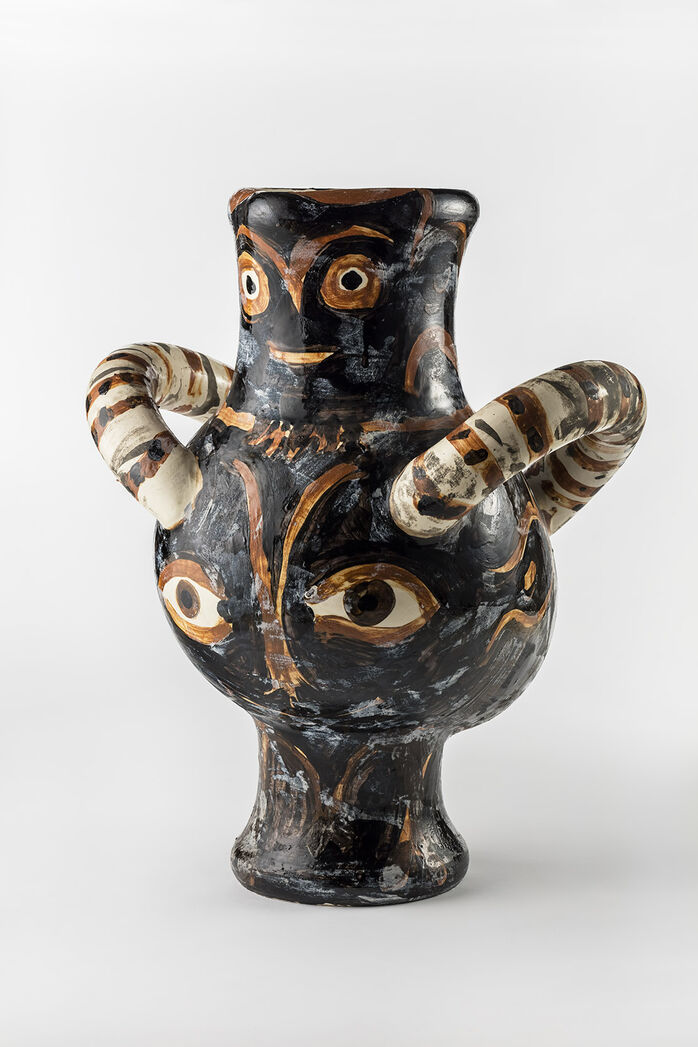파블로 피카소 컬렉션

파블로 피카소는 91세의 나이로 생을 마감할 때까지 인간으로서, 예술가로서 극적인 삶을 살았습니다.
1881년 스페인 아달루시아 지방의 지중해가 내려다보이는 말라가에서 태어난 피카소는 어려서부터 그림에 재능을 보였고, 화가이자 교사였던 아버지의 가르침을 받아 아버지를 능가하는 뛰어난 소묘력을 보여주었습니다. 을 보여주었습니다.
파블로 피카소는 91세의 나이로 생을 마감할 때까지 인간으로서, 예술가로서 극적인 삶을 살았습니다.
1881년 스페인 아달루시아 지방의 지중해가 내려다보이는 말라가에서 태어난 피카소는 어린 시절부터 그림에 재능을 보였고, 화가이자 교사였던 아버지의 가르침을 받아 아버지를 능가하는 소묘력을 보였습니다. 14세에 바르셀로나로 이주한 그는 이듬해 미술학교에 입학하고, 1900년 파리로 건너가 툴루즈 로트렉[1864-1901]의 영향을 받아 학문적 표현을 버리고 본격적으로 화가의 길을 걷기 시작합니다. 그의 인생은 굴곡이 많았고, 일생 동안 여러 여성들이 연이어 등장하는데, 이 여성들은 피카소의 창작 활동에 영감을 주며 피카소의 화풍을 변화시키는 계기가 되기도 했다.
피카소는 큐비즘처럼 지적으로 대상을 분석한 리듬감 넘치는 작품을 그렸다면, 고전주의적인 촉촉한 작품을 그리며 애정과 유머가 넘치는 작품을 만들어내는 한편, 격렬한 분노의 외침이 들리는 듯한 작품을 제작하기도 했다. 시기나 스타일이 다른 피카소의 작품을 비교해보면, 너무도 다양해서 마치 전혀 다른 사람이 그린 것처럼 보일 정도다. 하지만 모든 작품은 피카소의 삶을 반영하고 있으며, 그의 현실을 바라보는 일관된 의지와 태도를 느낄 수 있다.
현재 피카소의 작품을 전문적으로 소장하고 있는 미술관은 출생지인 말라가, 청년기를 보낸 바르셀로나, 인생의 대부분을 보낸 파리, 고성을 아틀리에로 사용했던 앙티브, 남프랑스의 도예 도시 발로리스 등에 있으며, 각기 다른 특징을 가지고 있습니다. 의 피카소관은 피카소의 딸인 마야 피카소[1935~2022]로부터 구입한 도예 작품 188점이 컬렉션의 중심을 이루고 있다. 화려한 색채와 장난기 넘치는 작품들은 친근하게 다가와 보는 이에게 풍요로운 즐거움을 선사한다.
그 외에도 조각, 회화, 타피스트리, 제뮐, 금 오브제, 은으로 만든 콤포트 등 다양한 작품들이 전시되어 있습니다. 호기심 많고 탐구심이 강했던 피카소는 다양한 조형에 도전하며 독자적인 표현을 개척해 왔다. 제1차 세계대전, 스페인 전쟁, 제2차 세계대전 등 격변의 20세기를 피카소는 놀라운 창조력과 에너지로 살아냈고, 그 업적은 생전에 이미 압도적인 평가를 받으며 20세기 미술의 최고봉으로 우뚝 솟게 되었습니다.

'아루칸'
1905년 청동 40 x 35 x 22cm, 청동
페르난도 올리비에[1881-1966]라는 연인을 만나면서 피카소의 화면은 '푸른 시대'의 우울함과 결별하고 점차 따뜻한 행복감을 읽을 수 있는 '장미빛 시대'로 넘어간다. 이 시기 피카소는 사회의 관습에서 한 발짝 벗어난 방랑자인 서커스 단원들을 감성적인 분위기로 많이 그렸는데, 이 《아르캉》(광대)은 절친한 친구인 막스 자코브[1876~1944]와 함께 서커스를 보러 갔던 날 밤에 그린 작품이다.
페르난도 올리비에[1881-1966]라는 연인을 얻으면서 피카소의 화면은 '푸른 시대'의 우울함과 결별하고 점차 따뜻한 행복감을 읽을 수 있는 '장미빛 시대'로 넘어간다. 이 시기 피카소는 사회의 관습에서 한 발짝 벗어난 방랑자인 서커스 단원들을 감성적인 분위기로 많이 그렸는데, 이 <아르캉>(광대)은 절친한 친구인 막스 자코브[1876~1944]와 서커스를 보러 간 날 밤에 그린 작품이다.
처음에는 자코브와 비슷했던 얼굴이 수정하는 과정에서 얼굴의 상반신이 바뀌었고, 그 결과 모자가 추가되어 완성된 작품은 애매한 웃음을 짓는 알루캉이 되었다고 전해지고 있다. 거친 터치 속에서 강력한 표현이 탄생했고, 얼굴 조형의 섬세함과 모자의 소박함의 대비가 극적인 효과를 가져왔다. 피카소는 이후에도 광대에 대한 애정을 가지고 계속 그림을 그렸다. '장미빛 시대' 이후부터 말년까지 피카소와 함께 성장하고 변화한 광대의 모습이 문득 떠오른다.

'미노트로마시'
원판화(1935년): 파블로 피카소
제작(1982년): 이베트 코키르 플랑타피스리 318x 450cm
파블로 피카소의 작품을 모티브로 이베트 코킬-프린스가 제작한 태피스트리
1930년대 피카소의 작품에는 미노타우로스라는 소머리의 그리스 신화 속 괴물이 등장한다.
피카소는 인간적인 나약함, 애정, 유머와 야수의 흉포함, 육욕, 잔인함을 동시에 지닌 미노타우로스의 다양한 성격에 공감하고 매료되었다. 자신의 내면에 있는 야수성을 미노타우로스에 투영해 보았을 것이다.
1930년대 피카소의 작품에는 미노타우로스라는 소머리의 그리스 신화 속 괴수가 등장한다.
피카소는 인간적인 나약함, 애정, 유머와 야수의 흉포함, 육욕, 잔인함을 동시에 지닌 미노타우로스의 다양한 성격에 공감하고 매료되었다. 자신의 내면에 있는 야수성을 미노타우로스에 투영해 보았을 것이다. 그의 판화 작품 중 최고 걸작인 《미노타우로스로마시》는 1935년, 유럽이 제2차 세계대전으로 치닫는 불안한 분위기 속에서 그려졌다. 미노타우로스는 사랑스러운 소녀가 내민 양초의 불빛 앞에서 두려움에 떨고 있다. 중앙에는 배를 찢겨 고통스러워하는 말과 말 등에 누워 있는 아름다운 여 투우사. 왼손에는 수염을 기른 남자가 도망치는 모습, 위쪽 창문에는 두 여자가 비둘기와 함께 비둘기에게 다가와 지켜보고 있다. 다양한 해석이 가능한 작품이지만, 그 소재는 2년 후의 대작 《게르니카》(1937년, 마드리드 소피아 왕립예술센터)의 비극을 예고하는 상징성을 가지고 있어 불길한 분위기를 느끼게 한다. 이 태피스트리는 《미노토로마시》의 원판화를 바탕으로 실의 선택부터 마무리까지 태피스트리 작가인 이베트 코키르-프랭스[1928~2005]가 제작했다.

'고양이가 있는 정물'
1962년 10월 23일-11월 1일, 유채, 캔버스 130x 162cm
금방이라도 달려들 것 같은 고양이. 그 사나운 얼굴은 먹이를 얻은 기쁨으로 빛나고 있다.
"피카소는 어느 날 여성의 석고상을 만들기 시작했는데, 완성된 것은 고양이 상이었다"는 에피소드에서 알 수 있듯이, 피카소는 고양이에게 유연하고 야성적인 '여성'의 모습을 겹쳐서 보았다.
금방이라도 달려들 것 같은 고양이. 그 사나운 얼굴은 먹잇감을 얻은 기쁨으로 빛나고 있다.
"피카소는 어느 날 여성의 석고상을 만들기 시작했는데, 완성된 것은 고양이 상이었다"라는 에피소드에서 볼 수 있듯이 피카소는 고양이에게 유연하고 야성적인 '여성'의 모습을 겹쳐서 보았다. 또한 "나는 살롱의 소파 위에서 호화로운 고양이들이 아니라 털을 거꾸로 세우고 야생으로 돌아간 고양이를 무작정 좋아한다"고 친구이자 사진작가인 브라사이[1899-1984]에게 말했다고 한다. 이 작품은 18세기의 대표적인 정물화가 장 바티스트 시메온 샤르댕[1699-1779]이 그린 《붉은 고양이》(1725-26년, 파리 루브르 박물관)를 떠올리게 하지만, 샤르댕이 그린 사실적인 작은 고양이에 비해 피카소의 고양이는 거칠게 그려져 있다, 야생적이고 그 강렬함은 주변을 압도한다. 반면 책상 위에 놓여 금방이라도 공격할 것 같은 랍스터의 표정과 형태에서 유머가 느껴지고, 그 긴 촉각은 화면에 강렬한 임팩트를 준다.


'프랑코의 꿈과 거짓말'
1937년 1월 8일 - 6월 7일 에칭, 아쿠아틴트, 종이 31x 42cm (2장)
1936년, 공화국 정부에 대한 파시스트들의 반란이 시작되면서 스페인은 3년간의 내란 상태에 들어간다. 피카소는 파리 만국박람회에서 조국의 공화국 정부에 대한 경제적 지원을 목적으로 <프랑코의 꿈과 거짓말>이라는 동판화 2점과 자필 시를 제작했다.
1936년, 공화국 정부에 대한 파시스트의 반란이 시작되고 스페인은 3년간의 내란 상태에 들어간다. 피카소는 파리 만국박람회에서 조국의 공화국 정부에 대한 경제적 지원을 목적으로 <프랑코의 꿈과 거짓말>이라는 동판화 2점과 자필 시를 제작했다.
"그림은 아파트를 꾸미기 위해 그리는 것이 아니다. 그것은 잔인함과 어둠과의 싸움을 위한 무기다"라는 피카소의 말처럼 이 작품은 반란군 지도자 프란시스코 프랑코[1892-1975]에 대한 신랄한 비판인 동시에 공화국 정부에 대한 지지를 표명하는 것이었다. 많은 사람들에게 호소하기 위해 그는 한 눈에 알아볼 수 있는 작품을 만들었다. 그것은 18연작의 화면에서 오른쪽에서 왼쪽으로 진행되는데, 그 주인공은 그로테스크한 추악한 모습으로 모든 것을 파괴하는 프랑코이다. 그러나 피카소는 스페인의 상징인 황소를 등장시켜 프랑코의 사악한 모습에 뿔을 꽂아 넣었다. 게다가 구세주로서의 황소, 태양, 죽어가는 말, 아이를 안고 울부짖는 여인 등 《게르니카》의 해석의 단초가 되는 소재도 많이 등장한다. 그 강렬한 화면은 강렬한 풍자 정신으로 가득 차 있으며, 프랑코의 비열함과 잔인함이 고스란히 전해지는 듯하다. 이 판화 제작을 중단한 후인 1937년 4월 26일, 스페인 북부의 작은 마을 게르니카를 프랑코를 지원하는 나치 독일군이 무차별 공격을 감행했다. 파리에서 이 소식을 들은 피카소는 격분하여 대작 《게르니카》를 그리기 시작한다. '프랑코의 꿈과 거짓말'의 마지막 4장면은 '게르니카' 제작 이후에 그려진 것이다.

'타우로마키아(투우)'
1957년 슈가 리프트 아쿠아틴트, 종이 19.8×29.4cm (26장)
이 작품은 호세 델가도(페페 일요)[1754-1801]가 쓴 『투우기술』(1796년)에 피카소가 26점의 삽화를 붙인 작품이다. 피카소가 데이비드 더글러스 던컨에게 개인적으로 선물했고, 이후 조각의 숲 미술관에 소장되었다.
이 작품은 호세 델가도(페페 일요)[1754-1801]가 쓴 『투우기술』(1796)에 피카소가 26점의 삽화를 붙인 것이다. 피카소가 데이비드 더글라스 던컨에게 개인적으로 선물했고, 이후 조각의 숲 미술관에 소장되었다. 피카소는 8살 때 처음으로 유화를 그렸는데, 아버지가 자주 데려갔던 투우를 그린 그림이었다. 피카소의 삶에서 투우는 가장 큰 즐거움 중 하나이자 필수불가결한 것이었다. 신성한 의식이자 열광적인 드라마였다. 이 작품은 1957년 봄, 투우를 본 다음 날 오후 식탁에 앉아 3시간도 채 안 되는 시간에 제작되었다.
슈가 리프트 아쿠아틴트(Sugar Lift Aquatint)라는 기법을 사용했다. 이는 설탕을 이용한 에칭의 일종으로, 일반 에칭보다 더욱 회화에 가까운 효과를 얻을 수 있다. 붓으로 직접 동판에 그림을 그릴 수 있기 때문에 다양한 터치로 풍부하고 아름다운 효과를 얻을 수 있다. 피카소의 묘사력과 기법의 효과로 투우사와 황소의 민첩한 움직임과 사람들의 웅성거림이 생생하게 그려져 있다.

'화가와 모델'
1963년 3월 5일-9월 20일, 유채, 캔버스 89×116.3cm
말년에 피카소를 사로잡아 반복적으로 그려진 주제 중 하나가 '화가와 모델'이다. 못생기고 늙은 화가는 젊고 아름다운 모델 앞에서 무표정하게 바라볼 뿐이다.
말년에 피카소를 사로잡아 반복적으로 그려진 주제 중 하나가 '화가와 모델'이다. 못생기고 늙은 화가는 젊고 아름다운 모델 앞에서 무표정하게 바라볼 뿐이다. 그것은 피카소의 마음 속 깊은 곳을 가장 직접적으로 드러낸 주제이기도 했다. '늙음'과 정면으로 마주했을 때, 피카소는 자신에게도 가차없이 무자비한 자학적인 시선을 보낸다. 거친 필치에는 생동감 넘치는 '성'에 대한 선망의 눈빛과 '죽음'을 외면할 수 없는 피카소의 고통이 느껴지는 듯하다. 작품 제작 속도는 점점 빨라지고, 겉보기에는 조잡해 보이지만 형태를 잃지 않고 정력적으로 표현하고 있다. 그에게 그림은 자서전과도 같은 것으로, 주제를 선택하는 것은 그의 의지가 아니라 그의 삶이었다고 할 수 있다.
도예
1946년 여름, 피카소는 프랑수아즈 질로와 함께 발로리스에서 열리는 도예 전시회에 갔다. 이때 그는 점토를 손에 들고 3점의 인물상을 만들었다. 이듬해 여름 피카소는 다시 발로리스를 방문했고, 자신이 만든 작품이 구워져 보존되어 있는 것을 보고 매우 기뻐했다고 한다.
1946년 여름, 피카소는 프랑수아즈 질로와 함께 발로리스에서 열리는 도예 전시회에 갔다. 이때 그는 점토를 손에 들고 3점의 인물상을 만들었다. 이듬해 여름 피카소는 다시 발로리스를 방문했고, 자신이 만든 작품이 구워져 보존되어 있는 것을 보고 매우 기뻐했다고 한다. 이후 그는 '마두라'라는 도자기 공방을 운영하는 도예가 조르주 라미에 부부의 아낌없는 도움을 받아 폭발적인 속도로 작품을 만들어 나갔다. 주제는 여성, 비둘기, 비둘기, 벌레, 얼굴, 투우, 목신, 식물 등 피카소의 주특기인 주제들로 이루어져 있으며, 마음껏 즐기며 작업한 흔적이 느껴진다. 작품에서 그의 유머가 느껴지고, 어린 시절로 돌아간 듯한 피카소의 감성이 가득하다.

'눈과 태양'
1957년 5월 20일 도자기 ∅42cm

'목신의 얼굴'
1948년 3월 10일 도자기 32.2 × 38 cm

'미미즈쿠'
1961년 2월 18일 세라믹 57.5 x 46 x 41.5 cm

"새」도자기
1954년경 도자기 55.5 × 42 x 20 cm, 도자기

"목걸이를 한 비너스
1947년경 도자기 38x 11x8.3cm, 세라믹, 1947년경
데이비드 더글라스 던컨
[미국 1916-2018]
1957년경 사진



던컨은 한국전쟁과 베트남 전쟁 보도 사진으로 유명한 사진 저널리스트였다. 그가 피카소를 처음 만난 것은 피카소가 75세였던 1956년이었다.
던컨은 한국전쟁과 베트남전쟁 보도사진으로 유명한 사진 저널리스트였다. 그가 피카소를 처음 만난 것은 1956년, 피카소 75세 때였다. 수많은 비참한 전쟁을 지켜본 던컨이었지만, 피카소와 처음 대면한 날은 "그리 평범하지 않은 일생에서도 드물게 찾아온 하루였다"고 기록하고 있다.
그는 피카소의 재능과 강렬한 개성, 강력한 생명력에 한눈에 매료되어 이후 17년 동안 피카소가 사망할 때까지 친밀한 교류를 이어갔다.
그는 피카소의 집에 자유롭게 드나들 수 있는 몇 안 되는 친구 중 한 명이 되었고, 카메라를 든 던컨 앞에서 피카소는 전혀 의식하지 않고 자연스럽게 행동했다고 한다.
던컨은 피카소의 사적인 모습을 렌즈를 통해 이전에는 볼 수 없었던 피카소의 사적인 모습을 예리하게 포착했다.